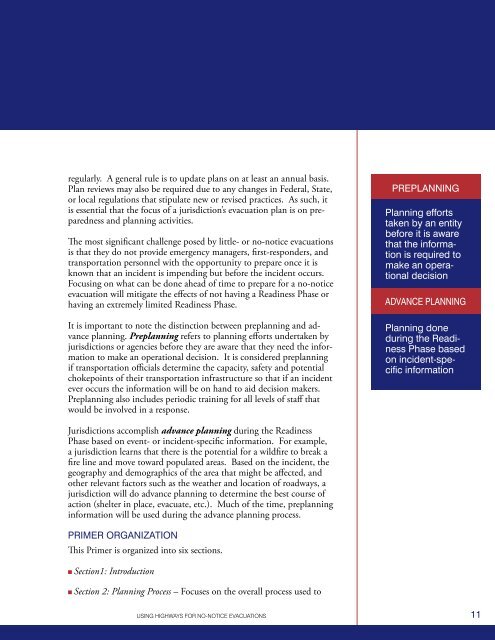using highways for no-notice evacuations - FHWA Operations - U.S. ...
using highways for no-notice evacuations - FHWA Operations - U.S. ...
using highways for no-notice evacuations - FHWA Operations - U.S. ...
Create successful ePaper yourself
Turn your PDF publications into a flip-book with our unique Google optimized e-Paper software.
egularly. A general rule is to update plans on at least an annual basis.Plan reviews may also be required due to any changes in Federal, State,or local regulations that stipulate new or revised practices. As such, itis essential that the focus of a jurisdiction’s evacuation plan is on preparednessand planning activities.The most significant challenge posed by little- or <strong>no</strong>-<strong>no</strong>tice <strong>evacuations</strong>is that they do <strong>no</strong>t provide emergency managers, first-responders, andtransportation personnel with the opportunity to prepare once it isk<strong>no</strong>wn that an incident is impending but be<strong>for</strong>e the incident occurs.Foc<strong>using</strong> on what can be done ahead of time to prepare <strong>for</strong> a <strong>no</strong>-<strong>no</strong>ticeevacuation will mitigate the effects of <strong>no</strong>t having a Readiness Phase orhaving an extremely limited Readiness Phase.It is important to <strong>no</strong>te the distinction between preplanning and advanceplanning. Preplanning refers to planning ef<strong>for</strong>ts undertaken byjurisdictions or agencies be<strong>for</strong>e they are aware that they need the in<strong>for</strong>mationto make an operational decision. It is considered preplanningif transportation officials determine the capacity, safety and potentialchokepoints of their transportation infrastructure so that if an incidentever occurs the in<strong>for</strong>mation will be on hand to aid decision makers.Preplanning also includes periodic training <strong>for</strong> all levels of staff thatwould be involved in a response.PREPLANNINGPlanning ef<strong>for</strong>tstaken by an entitybe<strong>for</strong>e it is awarethat the in<strong>for</strong>mationis required tomake an operationaldecisionADVANCE PLANNINGPlanning doneduring the ReadinessPhase basedon incident-specificin<strong>for</strong>mationJurisdictions accomplish advance planning during the ReadinessPhase based on event- or incident-specific in<strong>for</strong>mation. For example,a jurisdiction learns that there is the potential <strong>for</strong> a wildfire to break afire line and move toward populated areas. Based on the incident, thegeography and demographics of the area that might be affected, andother relevant factors such as the weather and location of roadways, ajurisdiction will do advance planning to determine the best course ofaction (shelter in place, evacuate, etc.). Much of the time, preplanningin<strong>for</strong>mation will be used during the advance planning process.PRIMER ORGANIZATIONThis Primer is organized into six sections.n Section1: Introductionn Section 2: Planning Process – Focuses on the overall process used toUSING HIGHWAYS FOR NO-NOTICE EVACUATIONS11
















